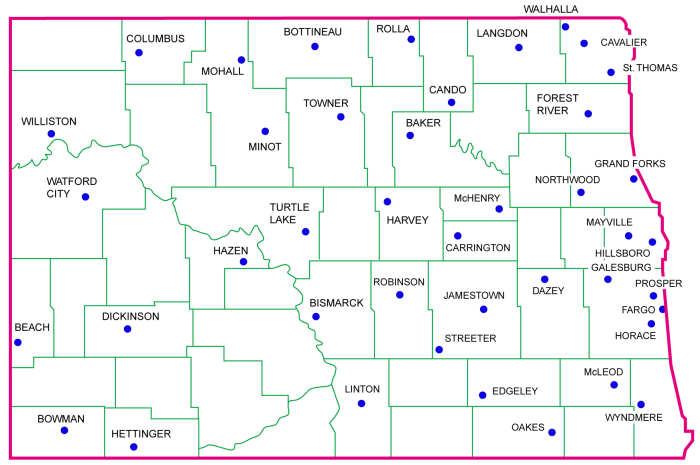


ノースダコタ州の農業は、国内の農作物生産において高いランクにあります。デュラム小麦、春小麦、大麦、ヒマワリ、亜麻、すべての食用豆では第 1 位、オート麦とすべての小麦では第 2 位、ジャガイモでは第 3 位、ライ麦とテンサイでは第 4 位です。これらのランキングを維持するには、病気、害虫、その他の敵対要因による予測不可能な攻撃にもかかわらず、私たちの農業は高品質の作物を大量に生産し続けなければなりません。
農薬散布は環境面で議論の的となっているものの、農作物の病気や害虫を防除するための農家の主な手段です。科学者は、一部の生物の発育を左右する重要な気象条件を特定し、この関係を模倣またはモデル化するプログラムを作成しました。現在の気象データを入力として使用することで、コンピュータ モデルは特定の病気や生物の発育段階を正確に追跡できます。この情報に基づいて、農家は農薬を散布するかどうか、いつ散布するかを判断し、農薬散布で常に懸念される散布飛散による健康問題や訴訟問題を最小限に抑えます。
1989 年、ノースダコタ州立大学の農業気象学者ジョン・W・エンツの監督の下、ノースダコタ州内の 6 つの農業試験場に気象監視システムが設置されました。現在、このシステムは 50 の気象観測所にまで拡大し、ノースダコタ農業気象ネットワーク (NDAWN) として知られています。NDAWN のサイトは州全体に広がっており、農薬散布に不可欠なデータを提供しています。これは環境に優しい電子気象監視システムで、ジョン・エンツ (教授) と、ノースダコタ州立大学土壌科学気候学部門のラドゥ・カルコアナとグレッグ・ブロックバーグ (研究専門家) によって管理されています。このシステムによって収集されたデータは、驚くほど多様な目的でますます多くの個人や機関によって使用されています。
弊社の標準気象観測所では、気温と相対湿度をヴァイサラ HMP35C センサーで、風速と風向を Met One 014A および 024A センサーで、太陽放射を LI-COR LI200S および LI200X 日射計で、降雨量をテキサス エレクトロニック TE525 転倒マス式雨量計で、気圧をヴァイサラ PTA427 センサーで、裸地および芝生被覆条件での 10 cm 深さの土壌温度を熱電対またはサーミスターで測定しています。データは 41 台の CR10 データロガーと 9 台の 21X で毎時および毎日記録され、要約されます。すべてのサイトは電話でアクセスでき、37 か所は DC112 電話モデム (7 か所は携帯電話)、11 か所は VS1 音声モデムでアクセスできます。2 つのステーションは無線テレメトリでアクセスできます。
音声モデムは、瞬間的な気象データ(風速と風向、気温、相対湿度、深夜からの降水量)を提供します。このデータは、農薬の地上散布または空中散布に適切な法的気象条件が満たされているかどうかを農家が判断するのに役立ちます。
季節センサーは、特定のパラメータを監視するために、いくつかのステーションに設置されています。成熟したテンサイの樹冠下 (地面から 1 フィート) の温度と相対湿度は、追加の HMP35C で測定されます。収穫時のテンサイの根と冠の温度を測定するために、いくつかの追加のサーミスタが使用されます。太陽放射は、作物の潜在的蒸発散量 (PET) を計算する上で重要なパラメータです。PET は、毎日および毎週の作物の水使用量を計算するために使用され、農家がいつ、どのくらいの量を灌漑するかを決定するのに役立ちます。
基本的な測定に加え、特別な研究プロジェクトでは、特定のステーションでCampbellの AM416 マルチプレクサを介して他の変数を監視する必要があります。2 つのサイトでは、ノースダコタ州運輸省との共同研究プロジェクトで、高速道路の舗装の下の 14 の深さ (最大 10 フィート) で温度が監視されています。シェイエン国立草原における NDSU の長期研究プログラムの一環として、井戸で地下水位が監視されています。進行中の研究プロジェクトの一環として、州内の 13 のステーションで 12 の深さ (最大 6 フィート) で土壌温度が 1 時間に 1 回測定されています。別のサイトでは、北向きと南向きの斜面の両方で土壌温度のプロファイルが作成されています。
正確で信頼性の高いデータを提供するために (不良データはデータがないよりも悪いため)、私たちは品質管理 (QC) と予防保守 (PM) の緊急プログラムの資金調達と開発に力を注いできました。QC は 2 つの毎日のデータ品質管理フィルターによって支えられています。1 つはネブラスカ州リンカーンのハイプレーンズ気候センターによって実行され、これも毎日のデータを取得します。もう 1 つは NDSU の研究専門家によって実行されます。PM はステーションのダウンタイムと費用を最小限に抑えますが、追加のクランプやセンサーから CR10 や 21X に至るまで、工場で調整されたスペアパーツを十分に用意する必要があります。
各ステーションは、毎年、標準点検のために訪問されます。また、各ステーションで発生したすべての活動とイベントの詳細なログも保持しています。標準点検に加えて、追加の出張が必要となる緊急事態 (落雷、日射計または雨量計漏斗への鳥の糞、ソーラーパネルへの積雪など) もあります。
Campbell Scientificのアプリケーション エンジニアとの協力と電話での対応は、問題を正確に特定する上で非常に貴重です。多くの特殊で異常な状況を解決する上での彼らの貢献は非常に重要です。あるとき、4 者電話会議での協力作業で電話回線の問題が見つかりました。ノースダコタ州国家警備隊 (ステーションの所有者) の環境専門家であるポールは車内におり、ジョンはオフィスでコンピューターでステーションを監視していました。ラドゥは電話会社のハリスとともにステーションにおり、Campbell Scientificのアプリケーション エンジニアであるバートはユタ州ローガンにいました。
これは最先端の技術です。
ケーススタディの概要
アプリケーション
害虫駆除や蒸発散などの農業用途にデータを提供する州全体の気象観測所ネットワーク場所
ノースダコタ州、米国使用製品
LI200X-L 014A-L TE525-L寄稿者
Radu Carcoana, North Dakota State University参加団体
ノースダコタ州立大学、ノースダコタ州運輸局、ノースダコタ州国家警備隊計測項目
風速/風向、空気、土壌、作物の温度、降水量、太陽放射、相対湿度、気圧、地下水位関連ウェブサイト
NDAWN (North Dakota Agricultural Weather Network)PDFで見る